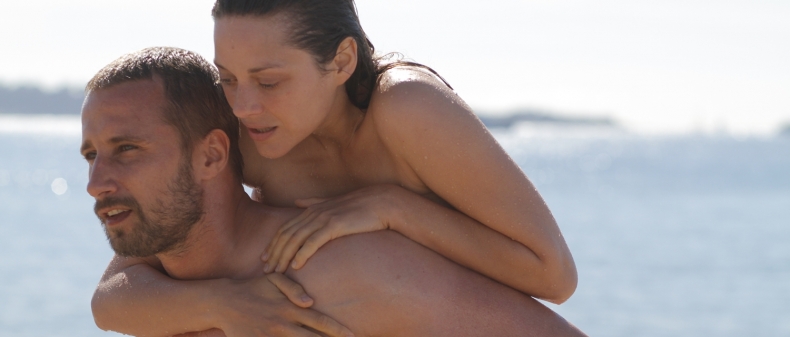
Jacques Audiard’s Rust and Bone is a relationship drama rendered in short, prismatic chunks. Dialogue is kept to a minimum and traditional character growth — the moments of insight, the changes in attitude — occur almost entirely off-screen. The heroine, who loses her legs in a freak accident early in the film, may be wracked with suicidal despair in one scene, but in the next she’s getting on with life, and there’s little indication of how she got from point A to point B. On the one hand, it’s refreshing being spared the tedium of the usual behavioural explanations. On the other, it sometimes feels as if something essential is being elided.
Based very loosely on a pair of short stories by Canadian author Craig Davidson, Rust and Bone features what could be considered shop-worn subject matter: two highly damaged people finding salvation in one another. But Audiard’s fast-moving, elliptical approach and the performances of the two leads keep things feeling fresh. Belgian actor Matthias Schoenaerts (Bullhead) plays a dirt-poor bare-knuckle boxer named Ali, who, when the film begins, has just relocated to a resort town in the south of France with his young son in the hopes of finding work. Though Ali is a well-meaning fellow, he has terrible interpersonal skills — he’s basically Lenny from Of Mice and Men with a few more I.Q. points. After getting a job as a bouncer at a trendy nightclub, he comes to the aid of the gorgeous, almond-eyed Stéphanie (Marion Cotillard), who’s just been assaulted by some jerk she spurned. It’s not the most auspicious meeting: driving Stéphanie home, Ali suggests she wouldn’t have been assaulted if she hadn’t been dressed “like a whore.” (This is his idea of helpful advice.) Stéphanie registers the insult and ends the evening as quickly as possible.
But then Stéphanie suffers that aforementioned accident, and it’s a real doozy. Working at a tacky aquatic park training killer whales, she’s in the midst of a particularly energetic routine — scored, kinda awesomely, to Katy Perry’s “Firework” — when one of her pupils gets a bit too close and crashes into her, crushing her legs. A cloud of red mars the water. Afterwards, when she comes to in a darkened hospital room, she props herself up on her elbows and discovers two stumps where her legs should be. (The digital erasing, incidentally, is seamless.) Happily, we aren’t made to slog through Stéphanie’s five stages of grief; we jump instead to a moment weeks later when she phones Ali out of the blue and asks him to come visit her at home. Something about his manner that night — his animal directness, maybe — has stuck with her, and she hopes it will come in handy now. She wants to be with someone who won’t pity her.
From this point on, the narrative lurches from highlight moment to highlight moment, and it’s up to you to decide if Audiard (The Beat That My Heart Skipped, A Prophet) is skimming the surface of this relationship or simply skipping the boring stuff. For instance, when Ali first goes to visit Stéphanie, she insists, emphatically, that she will not be leaving the house any time soon. Then, in the very next scene, she’s at the beach with him, learning anew how to swim. What made her change her mind? Who knows? But we can guess based on the many other films we’ve seen on this subject. Do we really need it spelled out for us?
The most obvious benefit of Audiard’s approach is that it allows for so many sudden, arresting moments: Stéphanie and Ali in bed together, her stumps newly tattooed with the words “Ã droite” and “Ã gauche”; Stéphanie freshly returned to the aquarium, communing peacefully with the beast who maimed her; Ali bashing his head against the back of a car seat after losing an illegal gypsy fight. Even more importantly, the approach encourages us to actively interpret rather than passively absorb; the speed of developments keeps us on our toes.
After awhile, however, I began to feel Audiard was taking advantage, that he was using the loose structure to excuse lazy and/or clichéd plotting. Why, for instance, does the sight of Stéphanie’s new prosthetic legs give Ali the strength to win a fight he’s been losing? And why does Stéphanie suddenly and improbably start running these bare-knuckle gypsy bouts? Most problematic of all is Ali’s relationship with his son, who seems to exist solely as a barometer for Ali’s mental and spiritual growth. Throughout the film, Ali is a terrible, borderline abusive dad, but we know his relationship with Stéphanie is changing him when he begins treating the boy better. And the boy’s status as prop is completely confirmed in a cheap, child-in-peril climax that comes out of nowhere.
Still, there’s a lot to enjoy and admire here, not least the tremendous performances of Schoenaerts and Cotillard. The latter, in particular, is in top form. This isn’t your typical Oscar-bait disability performance. Though Cotillard effortlessly fulfills the role’s physical requirements, it’s the subtle shades of feeling you’ll remember most. Her look of shame when she has to drag herself across a floor; her mixture of joy and envy watching the able-bodied dance in a nightclub; her guarded gestures when reuniting with old coworkers. We don’t even need to see Cotillard’s face to feel what she’s feeling. Her best scene — the one with the whale, post-accident — is framed with her back to us, her face pressed right to the aquarium glass. The big fellow floats before her, eager to perform, and she guides his movements with the gentlest of hand motions. Somehow, it feels as if she’s communicating her whole, sad story in every gesture.
____
Scott MacDonald writes about cinema for Toronto Standard. You can follow him on Twitter at @scottpmac. He just started tweeting, so be gentle with him.
For more, follow us on Twitter @TorontoStandard and subscribe to our newsletter.














